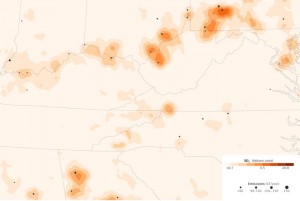The State Journal
By Taylor Kuykendall, Reporter
According to NASA, a team of scientists has detected major reductions in the levels of sulfur dioxide generated by Eastern U.S. coal plants from space, confirming ground-level measurements.
Sulfur dioxide, once heavily released into the air, is mostly scrubbed from coal-fired plants’ emissions before they are released. The pollutant is strongly linked to the formation of acid rain and health problems.
The findings suggest sulfur dioxide levels around coal plants have dropped more than half since 2005. Coal-fired plants contribute about two-thirds of sulfur-dioxide pollution.
“What we’re seeing in these satellite observations represents a major environmental accomplishment,” said Bryan Bloomer, an Environmental Protection Agency scientist. “This is a huge success story for the EPA and the Clean Air Interstate Rule.”
Much of the reductions, the report states, can be attributed to the 2005 Clean Air Interstate Rule (CAIR). When CAIR was proposed, it was estimated to achieve $85 to $100 billion in health benefits as well as another $2 billion in visibility benefits by 2015.
According to the EPA, CAIR would help West Virginia reduce emissions of sulfur dioxide by 422,000 tons, or 78 percent. Nitrogen oxide levels in West Virginia were expected to decrease by the same percentage, or 159,000 tons.
The EPA says West Virginia “significantly” contributes to fine particle pollution in District of Columbia, Maryland, Pennsylvania, Georgia, Ohio, New York, New Jersey, Kentucky, North Carolina, Tennessee and Delaware.
CAIR, the EPA claims, helps maintain coal as an economically viable resource and does not significantly affect electricity prices in the state. The EPA recently finalized the Cross-State Air Pollution Rule, which will replace the CAIR.
Ground-based pollutant measurement instruments have indicated a 46 percent reduction in sulfur dioxide emitted, a figure consistent with the study’s finding of a 40 percent reduction in the surrounding air.
“Now that we’ve confirmed that the technique works, the next step is to use it for other parts of the world that don’t have ground-based sensors,” said Nickolay Krotkov, a researcher at NASA’s Goddard Space Flight Center and coauthor of the paper. “The real beauty of using satellites is that we can apply the same technique to the entire globe in a consistent way.”
Scientists on the team hope to use the same techniques to study carbon dioxide emissions. The instrument used to measure the pollution is one of four installed on the NASA Aura satellite.
The device had previously been used to look at emission from volcanoes, but this was the first time such minute data was examined using the Ozone Monitoring Instrument.
